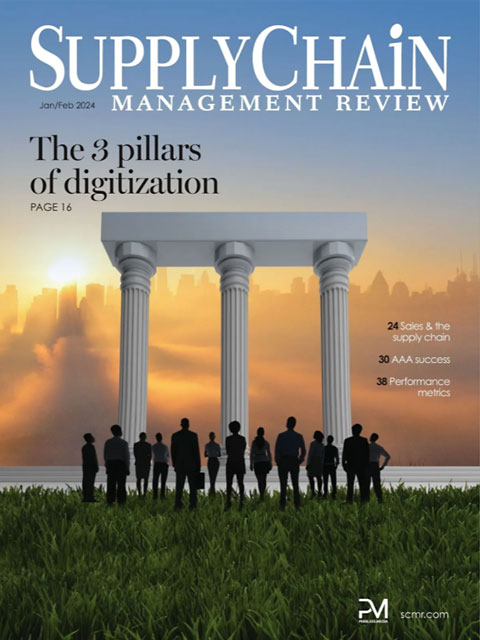Sorry, but your login has failed. Please recheck your login information and resubmit. If your subscription has expired, renew here.
January-February 2024
Back in 2019, we seemed on a consistent path to the future. Then COVID-19 arrived on the global scene, and all predictions went out the window. As 2024 begins, everyone wants to know what the year will look like. I predict continued interest in circular supply chains, cybersecurity, visibility, and digital supply chains, to name a few. But I am not alone. So, I’d like to share five things that I am particularly interested in this year. Browse this issue archive.Need Help? Contact customer service 847-559-7581 More options
As the global landscape of competition changes, it is not only the focal firm competing—it is the entire supply chain. The growing omni-channel environment coincides with abundant channel information that must be evaluated within and across supply chains. Supply chain management becomes critical to improving the bottom line as companies face more competition and increasing pressure to reduce lead times. Accordingly, closer relationships are required to ensure the efficient flow of products and information. The value of information sharing within a supply chain is evidenced by the benefits outweighing the costs. Supply chain members must recognize the importance of communication with internal stakeholders and external suppliers. In their 2013 corporate communications article, “Re-visiting the Supply Chain: A Communication Perspective,” Rossella Chiara Gambetti and Mattia Giovanardi noted that communication acts as a “cultural glue” and a “knowledge creation and dissemination” activity within the supply chain.
A company’s integration of its network of business relationships with information sharing is a crucial driver to success. Salespeople aid in bridging inter-organizational boundaries and increasing the connectivity of human resources across the supply chain. Today’s firms focus not only on maintaining a salesforce, but also on strategically using their sales organization and emphasizing the selling mission, wrote Thomas Leigh and Greg W. Marshall in their 2001 Journal of Personal Selling & Sales Management article, “Research Priorities in Sales Strategy and Performance.”
The last 50 years have seen movement from the salesperson and firm controlling most of the information about products to customers having unprecedented access to product information. Sales as a process has transitioned into being more of a solutions-based selling process to continue providing value to the customer. For years, firms relied more on relational selling to get their products into the hands of their buyers. Even in this stage, salespeople were an important piece in helping to build and solidify that relationship.
With the more recent transition to more of a solution-based sales approach for most firms, salespeople become even more important. Solution-based selling revolves around the focal point of selling your customer a solution to a problem and not just a particular product. Solution-based selling also focuses on the ROI of the product for the purchasing firm. For the buyer, this process enhances the buying experience as it offers support throughout the buying process.

This complete article is available to subscribers only.
Log in now for full access or start your PLUS+ subscription for instant access.
SC
MR
Sorry, but your login has failed. Please recheck your login information and resubmit. If your subscription has expired, renew here.
January-February 2024
Back in 2019, we seemed on a consistent path to the future. Then COVID-19 arrived on the global scene, and all predictions went out the window. As 2024 begins, everyone wants to know what the year will look like. I… Browse this issue archive. Access your online digital edition. Download a PDF file of the January-February 2024 issue.As the global landscape of competition changes, it is not only the focal firm competing—it is the entire supply chain. The growing omni-channel environment coincides with abundant channel information that must be evaluated within and across supply chains. Supply chain management becomes critical to improving the bottom line as companies face more competition and increasing pressure to reduce lead times. Accordingly, closer relationships are required to ensure the efficient flow of products and information. The value of information sharing within a supply chain is evidenced by the benefits outweighing the costs. Supply chain members must recognize the importance of communication with internal stakeholders and external suppliers. In their 2013 corporate communications article, “Re-visiting the Supply Chain: A Communication Perspective,” Rossella Chiara Gambetti and Mattia Giovanardi noted that communication acts as a “cultural glue” and a “knowledge creation and dissemination” activity within the supply chain.
A company’s integration of its network of business relationships with information sharing is a crucial driver to success. Salespeople aid in bridging inter-organizational boundaries and increasing the connectivity of human resources across the supply chain. Today’s firms focus not only on maintaining a salesforce, but also on strategically using their sales organization and emphasizing the selling mission, wrote Thomas Leigh and Greg W. Marshall in their 2001 Journal of Personal Selling & Sales Management article, “Research Priorities in Sales Strategy and Performance.”
The last 50 years have seen movement from the salesperson and firm controlling most of the information about products to customers having unprecedented access to product information. Sales as a process has transitioned into being more of a solutions-based selling process to continue providing value to the customer. For years, firms relied more on relational selling to get their products into the hands of their buyers. Even in this stage, salespeople were an important piece in helping to build and solidify that relationship.
With the more recent transition to more of a solution-based sales approach for most firms, salespeople become even more important. Solution-based selling revolves around the focal point of selling your customer a solution to a problem and not just a particular product. Solution-based selling also focuses on the ROI of the product for the purchasing firm. For the buyer, this process enhances the buying experience as it offers support throughout the buying process.
SC
MR


Latest Supply Chain News
Latest Podcast

 Explore
Explore
Business Management News
- The hard job of teaching soft skills
- Trump picks former Wisconsin congressman Sean Duffy for DOT secretary
- Made in Mexico, manufactured by China
- Retail sales see gains in October, reports Commerce and NRF
- Balancing green and speed: Home delivery insights from the pandemic era
- AdventHealth named top healthcare supply chain by Gartner
- More Business Management
Latest Business Management Resources

Subscribe

Supply Chain Management Review delivers the best industry content.

Editors’ Picks





